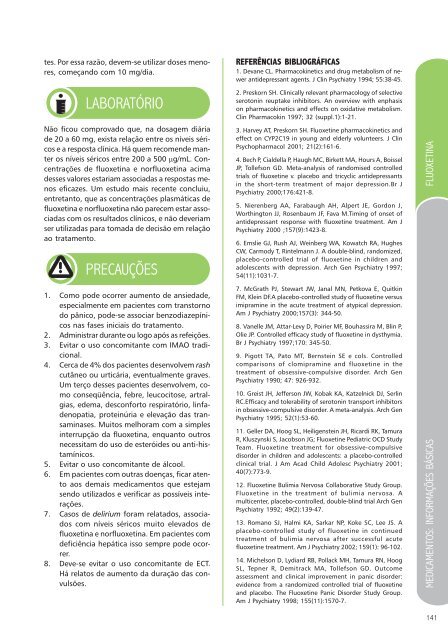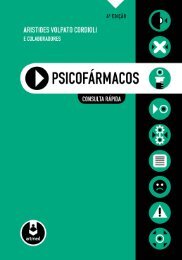Consulta Rápida - Psicofármacos - 1Ed.pdf
Create successful ePaper yourself
Turn your PDF publications into a flip-book with our unique Google optimized e-Paper software.
tes. Por essa razão, devem-se utilizar doses menores,<br />
começando com 10 mg/dia.<br />
REFERÊNCIAS BIBLIOGRÁFICAS<br />
1. Devane CL. Pharmacokinetics and drug metabolism of newer<br />
antidepressant agents. J Clin Psychiatry 1994; 55:38-45.<br />
LABORATÓRIO<br />
Não ficou comprovado que, na dosagem diária<br />
de 20 a 60 mg, exista relação entre os níveis séricos<br />
e a resposta clínica. Há quem recomende manter<br />
os níveis séricos entre 200 a 500 μg/mL. Concentrações<br />
de fluoxetina e norfluoxetina acima<br />
desses valores estariam associadas a respostas menos<br />
eficazes. Um estudo mais recente concluiu,<br />
entretanto, que as concentrações plasmáticas de<br />
fluoxetina e norfluoxetina não parecem estar associadas<br />
com os resultados clínicos, e não deveriam<br />
ser utilizadas para tomada de decisão em relação<br />
ao tratamento.<br />
PRECAUÇÕES<br />
1. Como pode ocorrer aumento de ansiedade,<br />
especialmente em pacientes com transtorno<br />
do pânico, pode-se associar benzodiazepínicos<br />
nas fases iniciais do tratamento.<br />
2. Administrar durante ou logo após as refeições.<br />
3. Evitar o uso concomitante com IMAO tradicional.<br />
4. Cerca de 4% dos pacientes desenvolvem rash<br />
cutâneo ou urticária, eventualmente graves.<br />
Um terço desses pacientes desenvolvem, como<br />
conseqüência, febre, leucocitose, artralgias,<br />
edema, desconforto respiratório, linfadenopatia,<br />
proteinúria e elevação das transaminases.<br />
Muitos melhoram com a simples<br />
interrupção da fluoxetina, enquanto outros<br />
necessitam do uso de esteróides ou anti-histamínicos.<br />
5. Evitar o uso concomitante de álcool.<br />
6. Em pacientes com outras doenças, ficar atento<br />
aos demais medicamentos que estejam<br />
sendo utilizados e verificar as possíveis interações.<br />
7. Casos de delirium foram relatados, associados<br />
com níveis séricos muito elevados de<br />
fluoxetina e norfluoxetina. Em pacientes com<br />
deficiência hepática isso sempre pode ocorrer.<br />
8. Deve-se evitar o uso concomitante de ECT.<br />
Há relatos de aumento da duração das convulsões.<br />
2. Preskorn SH. Clinically relevant pharmacology of selective<br />
serotonin reuptake inhibitors. An overview with enphasis<br />
on pharmacokinetics and effects on oxidative metabolism.<br />
Clin Pharmacokin 1997; 32 (suppl.1):1-21.<br />
3. Harvey AT, Preskorn SH. Fluoxetine pharmacokinetics and<br />
effect on CYP2C19 in young and elderly volunteers. J Clin<br />
Psychopharmacol 2001; 21(2):161-6.<br />
4. Bech P, Cialdella P, Haugh MC, Birkett MA, Hours A, Boissel<br />
JP, Tollefson GD. Meta-analysis of randomised controlled<br />
trials of fluoxetine v. placebo and tricyclic antidepressants<br />
in the short-term treatment of major depression.Br J<br />
Psychiatry 2000;176:421-8.<br />
5. Nierenberg AA, Farabaugh AH, Alpert JE, Gordon J,<br />
Worthington JJ, Rosenbaum JF, Fava M.Timing of onset of<br />
antidepressant response with fluoxetine treatment. Am J<br />
Psychiatry 2000 ;157(9):1423-8.<br />
6. Emslie GJ, Rush AJ, Weinberg WA, Kowatch RA, Hughes<br />
CW, Carmody T, Rintelmann J. A double-blind, randomized,<br />
placebo-controlled trial of fluoxetine in children and<br />
adolescents with depression. Arch Gen Psychiatry 1997;<br />
54(11):1031-7.<br />
7. McGrath PJ, Stewart JW, Janal MN, Petkova E, Quitkin<br />
FM, Klein DF.A placebo-controlled study of fluoxetine versus<br />
imipramine in the acute treatment of atypical depression.<br />
Am J Psychiatry 2000;157(3): 344-50.<br />
8. Vanelle JM, Attar-Levy D, Poirier MF, Bouhassira M, Blin P,<br />
Olie JP. Controlled efficacy study of fluoxetine in dysthymia.<br />
Br J Psychiatry 1997;170: 345-50.<br />
9. Pigott TA, Pato MT, Bernstein SE e cols. Controlled<br />
comparisons of clomipramine and fluoxetine in the<br />
treatment of obsessive-compulsive disorder. Arch Gen<br />
Psychiatry 1990; 47: 926-932.<br />
10. Greist JH, Jefferson JW, Kobak KA, Katzelnick DJ, Serlin<br />
RC.Efficacy and tolerability of serotonin transport inhibitors<br />
in obsessive-compulsive disorder. A meta-analysis. Arch Gen<br />
Psychiatry 1995; 52(1):53-60.<br />
11. Geller DA, Hoog SL, Heiligenstein JH, Ricardi RK, Tamura<br />
R, Kluszynski S, Jacobson JG; Fluoxetine Pediatric OCD Study<br />
Team. Fluoxetine treatment for obsessive-compulsive<br />
disorder in children and adolescents: a placebo-controlled<br />
clinical trial. J Am Acad Child Adolesc Psychiatry 2001;<br />
40(7):773-9.<br />
12. Fluoxetine Bulimia Nervosa Collaborative Study Group.<br />
Fluoxetine in the treatment of bulimia nervosa. A<br />
multicenter, placebo-controlled, double-blind trial Arch Gen<br />
Psychiatry 1992; 49(2):139-47.<br />
13. Romano SJ, Halmi KA, Sarkar NP, Koke SC, Lee JS. A<br />
placebo-controlled study of fluoxetine in continued<br />
treatment of bulimia nervosa after successful acute<br />
fluoxetine treatment. Am J Psychiatry 2002; 159(1): 96-102.<br />
14. Michelson D, Lydiard RB, Pollack MH, Tamura RN, Hoog<br />
SL, Tepner R, Demitrack MA, Tollefson GD. Outcome<br />
assessment and clinical improvement in panic disorder:<br />
evidence from a randomized controlled trial of fluoxetine<br />
and placebo. The Fluoxetine Panic Disorder Study Group.<br />
Am J Psychiatry 1998; 155(11):1570-7.<br />
FLUOXETINA<br />
MEDICAMENTOS: INFORMAÇÕES BÁSICAS<br />
141




